Crostoli
Crostoli are a crispy fried Italian pastries which are popular during Carnevale and many other holidays.
So light and flaky, Italian crostoli just melt in your mouth. Try stopping at just one – it’s impossible!
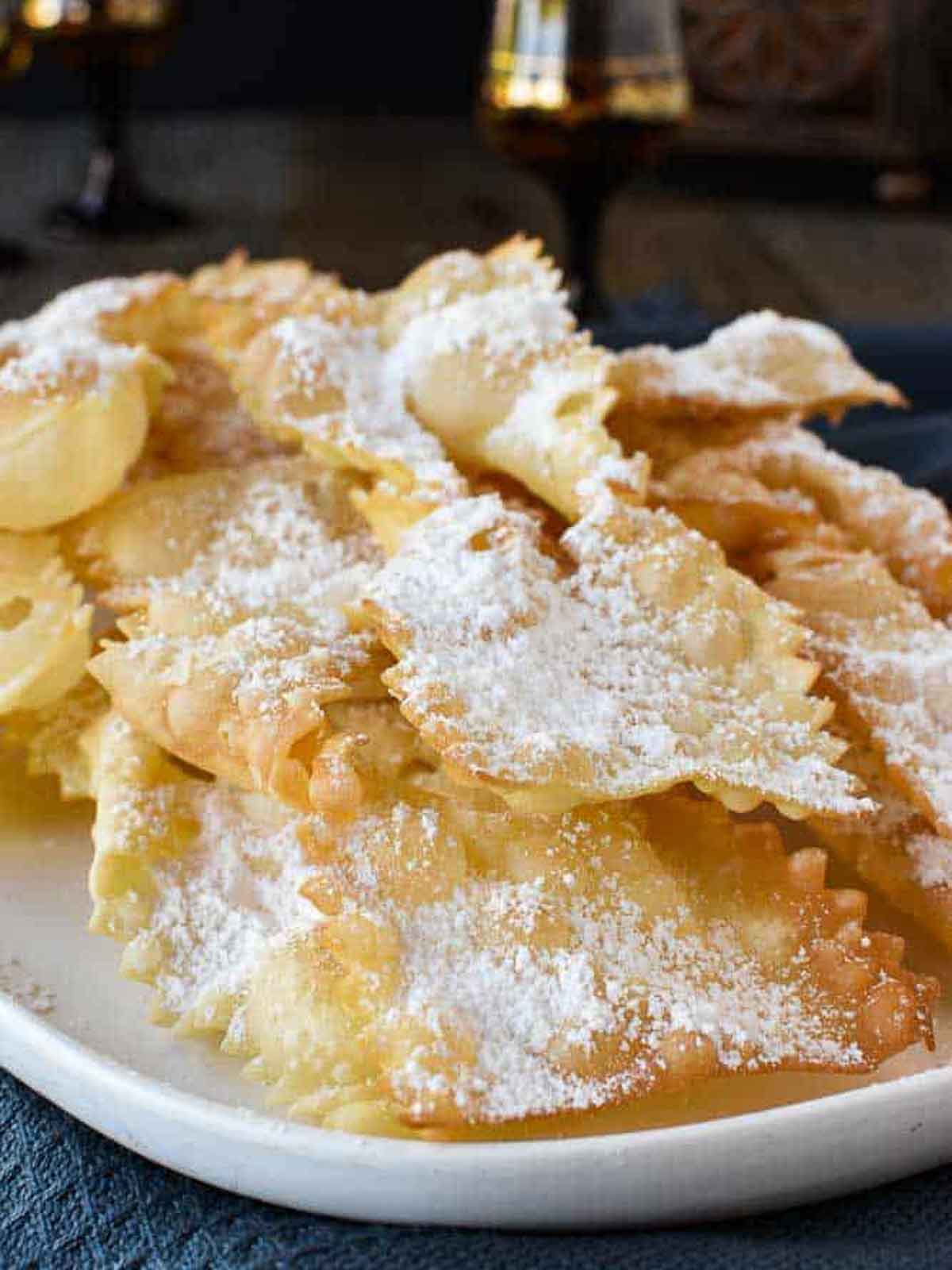
Table of Contents
Why you’ll love this recipe
Crostoli are traditional Italian pastries which are fried and dusted with sugar. What’s not to love!!
These pastries are eaten mostly at Carnevale which is the celebration just before Lent. However in Italy crostoli are sold in pastry shops throughout Lent. In other parts of the world these delicate pastries are also favourites at Christmas and other holidays.
Interestingly, this is the crispy, lighter-than-air fried pastry is also known in Italy by many other name such as cenci, bugie or chiacchiere di carnevale. I have always known this pastry as ‘storce’ pronounced ‘storch’. This comes from the Italian word ‘storto’ which mean twisted or crooked. In the little village of Camagna Monferrato, we were served a plate of freshly made ‘storce’ along with meaning of the name.
In other parts of the world, you might know these as angel’s wings or Italian bow ties. Fried, sweet pastry is common to many countries not just Italy.
While my late mother made delicious storce, her recipe went to the grave with her. So the recipe here is based on nonna’s Italian fried dough recipe. Nonna Lucia (my husband’s grandmother) passed on her knowledge to my mother-in-law and I have slightly adapted it.
For complete ingredient quantities and full instructions, please scroll to the printable recipe card at the bottom of the page.
Ingredients
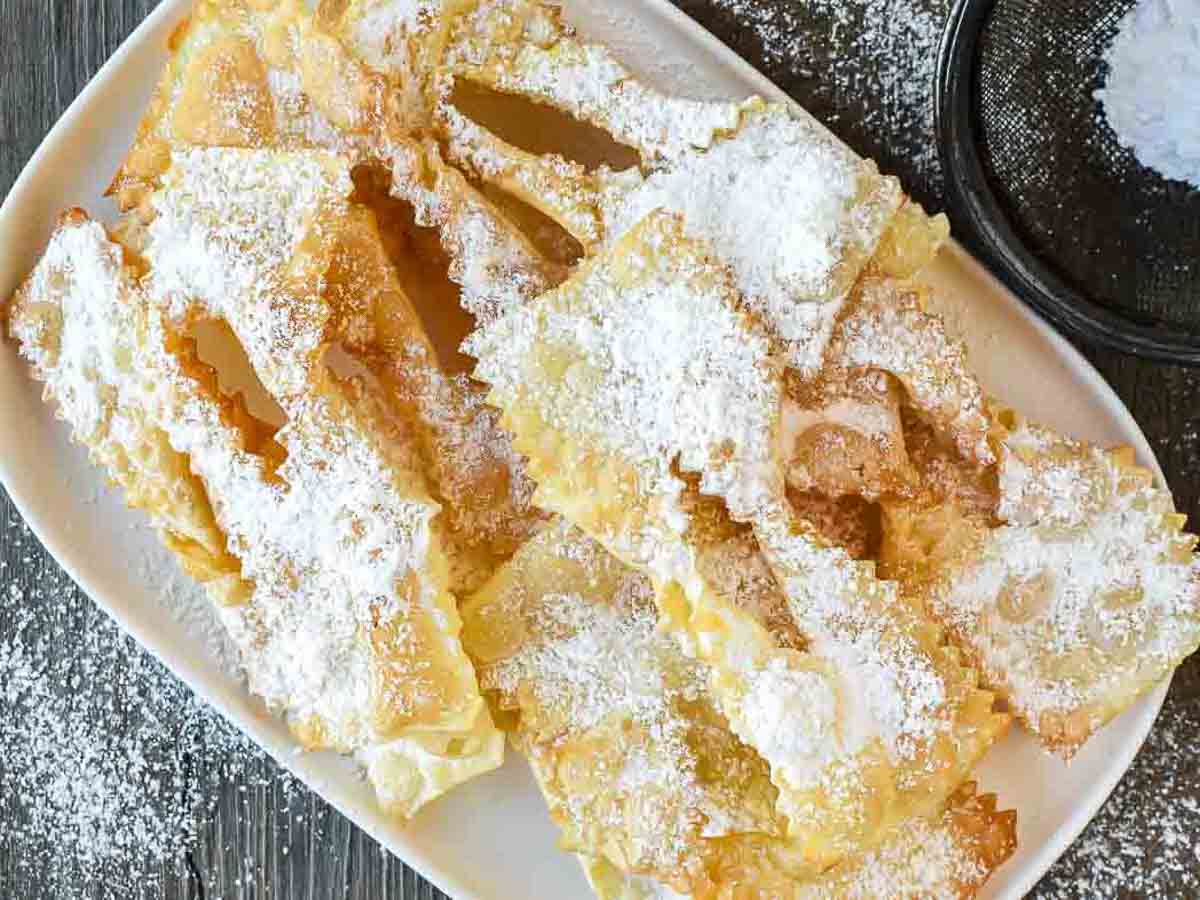
As with most traditional Italian recipes, the ingredients are very basic.
- flour
- eggs
- sugar
- brandy
- butter
- vanilla
- a pinch of salt for flavour
- oil for frying
Nonna’s recipe originally had no butter or vanilla but these adds extra flavour.
Instructions
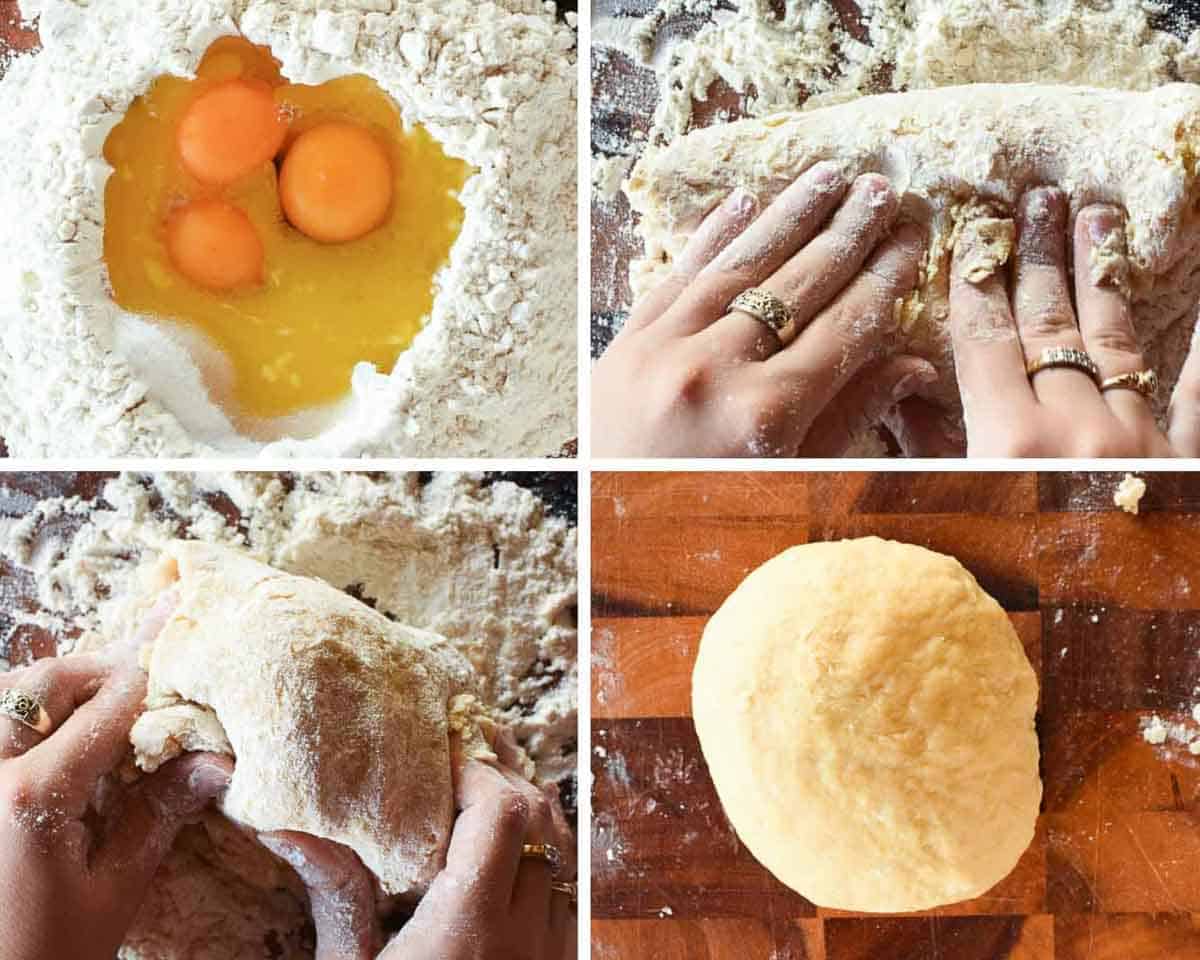
Basically this is pasta dough and you will find more details about making pasta such as tagliatelle and fagottini on my site. This dough can be made by hand or using a stand mixer.
To make this dough by hand:
- Place the flour onto a clean work surface.
- Make a well in the centre and add all the ingredients except the oil for frying.
- Use your fingertips or a fork to gradually blend the wet ingredient slowly gathering in flour to form dough.
- Knead well until smooth and elastic.
To make this dough with a stand mixer:
- Place flour into bowl of stand mixer.
- Add all ingredients except the oil for frying.
- Using a paddle attachment, mix to form dough.
- Switch to dough hook attachment and knead for about 5 minutes until the dough is smooth and elastic.
How to shape crostoli
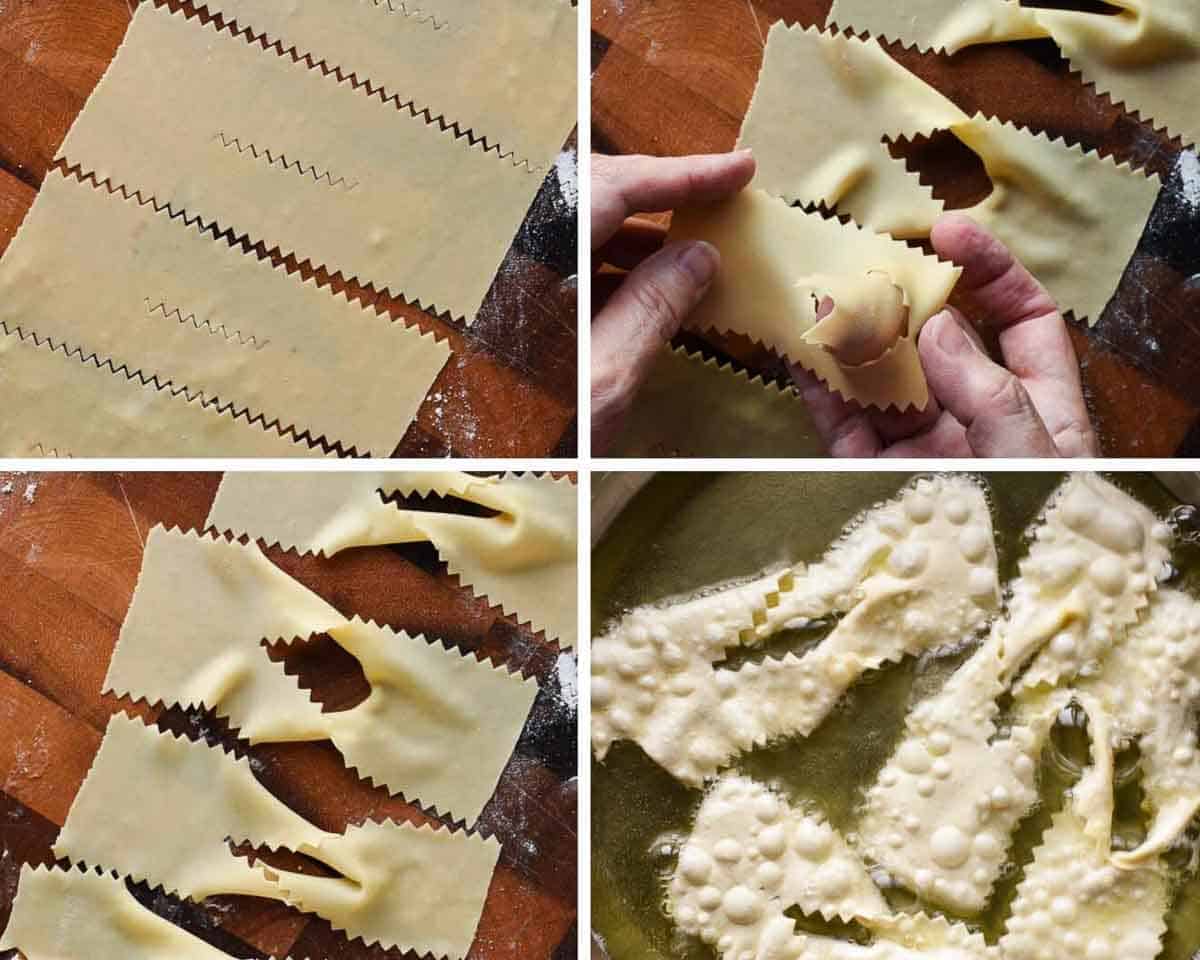
Roll the dough thinly and shape any way you desire. However in saying that these fried pastries are usually shaped by cutting a slit into strips of dough and one end folded through the slit. If you would like to make Italian bow ties, simply pinch the strips of the dough in the centre to form bow ties.
Try my Birds Nest Cookies for more festive treats.
Tips for Success
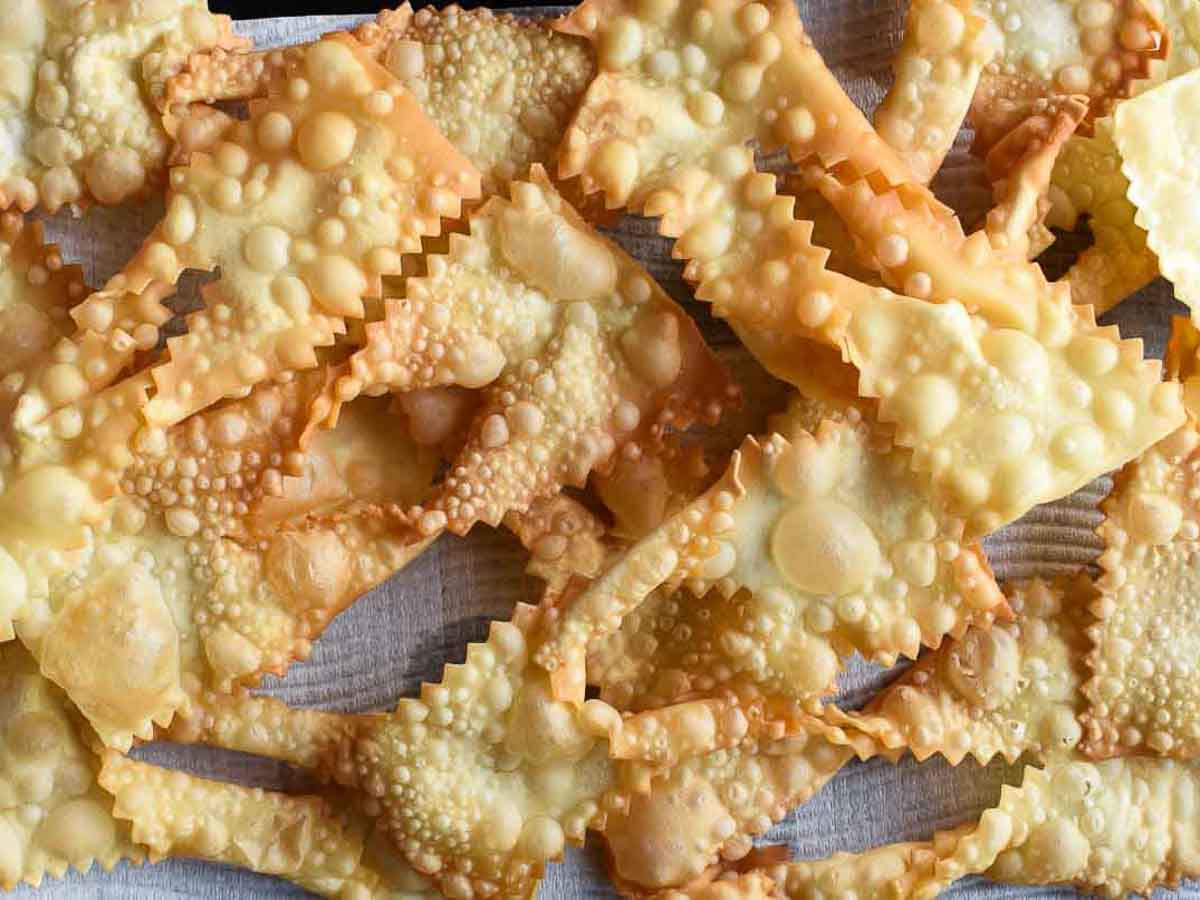
The nature of these Italian fried pastries is that they are delicate, crisp and crumble as you bite into them. To succeed with this recipe, there are a couple of important points to remember.
- The dough should be soft but not sticky.
- Roll the dough as thin as possible – almost see through.
- Don’t let the pastry dry out before frying.
- The oil must be hot – approx 180°C/350°F.
- Pastries must cook quickly so that they don’t absorb oil and become heavy.
FAQ
This recipe is much easier if you have a pasta machine. However it is possible to roll out the dough with a rolling pin. Admittedly, no one had pasta machines in years gone by! Stretching the dough as well as rolling the dough will help achieve the correct thinness.
This recipe uses brandy. Other recipes use grappa, rum, whiskey or even white wine. While I have never made these Italian pastries without alcohol, it is possible to substitute milk for the alcohol. The pastries may not bubble as well or have the same flavour but will still be delicious.
My preferred oil is grape seed oil because it has a high smoke point and neutral taste. But use any light flavoured oil – vegetable, canola or rice bran – will all work well.
This recipe makes quite a few pastries but these last for several weeks if stored well. Be sure to use an airtight container. I prefer tupperware which has a good seal. Line the base of the container with baking paper so that is comes up the sides a little. This will minimise crostoli absorbing a “plastic” smell. Lay a sheet over the top as well before sealing with the lid.
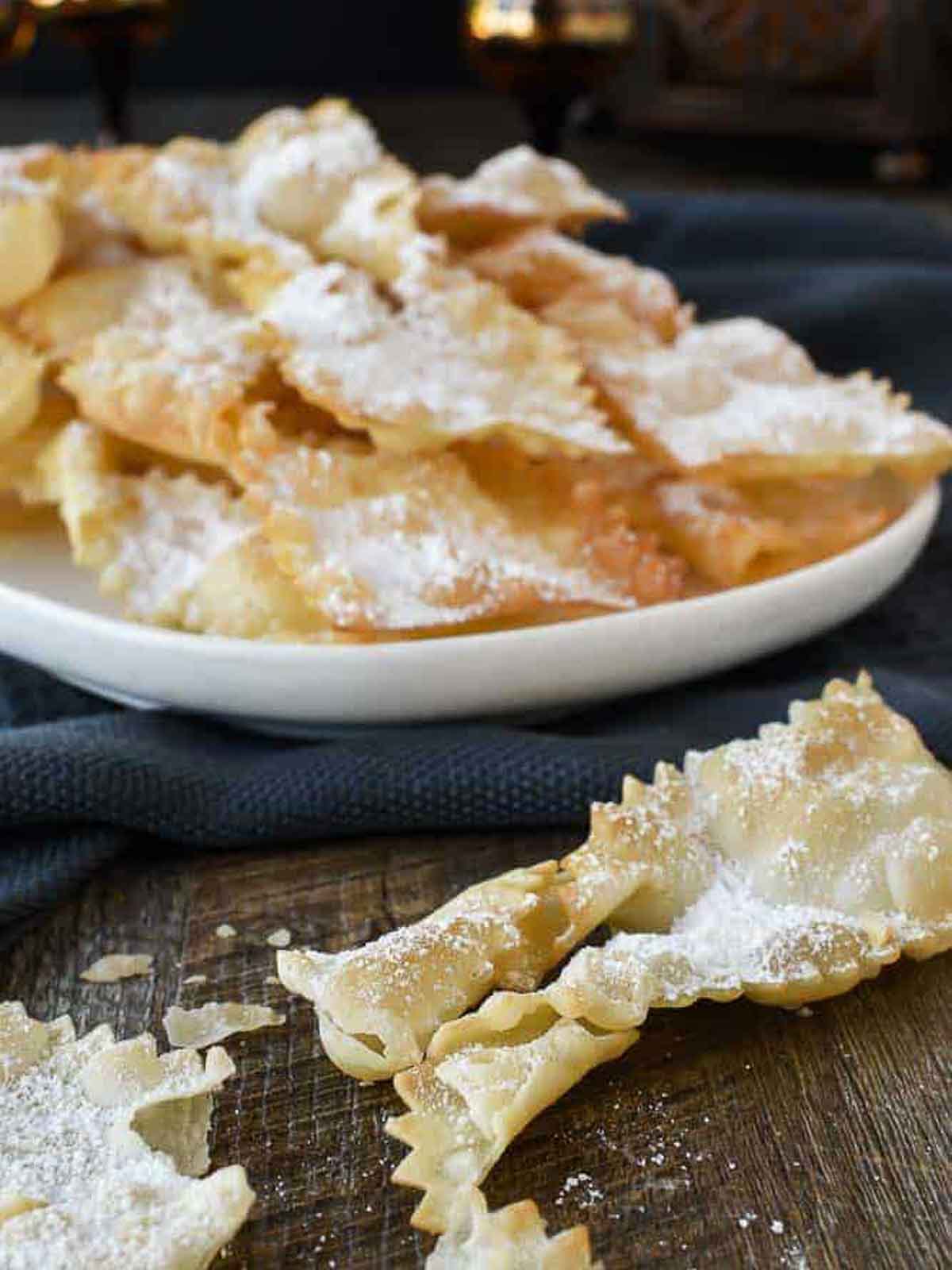
Call these Italian fried pastries crostoli, chiacchiere, angels wings or Italian bow ties, it doesn’t matter, the addiction is the same! Now everyone can enjoy a little bit of Italy at home.
Made this recipe?
Let me know if you liked it by leaving a ★★★★★ star rating and a review below. Don’t forget to subscribe to my newsletter – it’s free!
More Italian favorites for you
Pizzelle
Italian Pignoli Cookies
Orange and Almond Cookies
Italian Fig Cookies
Chewy Amaretti Cookies by It’s Not Complicated
Almond Cookies by It’s Not Complicated
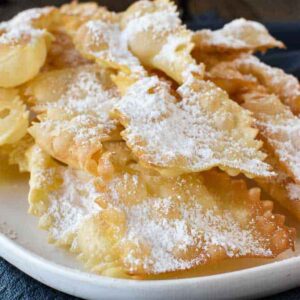
Crostoli Recipe
Ingredients
- 2 cups (250 grams) plain all purpose flour
- 2 whole eggs
- 1 egg yolk
- 2 tablespoon granulated white sugar
- 2 tablespoons (1 ounce/30 grams) butter slightly softened
- 1 tablespoon (15 mls) brandy see notes for substitutes
- 1 teaspoon vanilla extract
- pinch salt
- 2 cups grape seed oil for frying (rice bran or vegetable oil could be used)
- powdered sugar for dusting
Instructions
To make the Crostoli dough – hand mixing method
- Place the all purpose flour on a clean work surface.
- Make a well in the centre. Add the eggs, egg yolk, sugar, butter, brandy, vanilla extract and salt.
- Use your fingertips or a fork to gradually blend the wet ingredient slowly gathering in flour until the dough starts to come together. Add a little more brandy if needed to form a ball.
- Knead for about 5 minutes until the dough is smooth and elastic.
- Rest the dough for 30 minutes.
To make the Crostoli dough – stand mixer method
- Place the all purpose flour in a stand mixer bowl and attach the paddle attachment.
- Add the eggs, egg yolk, butter, brandy, sugar, vanilla extract and salt. Mix on low until combined.
- Switch to dough hook attachment and knead for about 5 minutes until the dough is smooth and elastic.
- Rest the dough for 30 minutes.
To roll and prepare Crostoli for frying
- Cut small portion of dough off the “mother” dough.
- Flatten the smaller piece and begin to pass through the pasta machine on the widest setting.
- Fold and pass it through the widest setting. Continue to fold and pass through the pasta machine 5 or 6 times until the dough is smooth.
- Dust with extra flour as required.
- Begin to reduce the setting until you are at the finest setting.
- Pass the dough through the finest setting and place the length of dough on to you work surface. With the Kitchen Aid Pasta roller, I find I need to go through the thinest setting twice. You could also manually (but carefully) stretch the dough to ensure it is as thin.
- Cut the dough along the length into about 2 inches (5 centimeter )strips which will be approximately 4 -6 inches (10-15 centimeters) long. This is just to give you an idea but really how you cut is up to you.
- I make a small cut in the middle of each piece and twist one end through the cut, as you can see above.
To fry Crostoli
- Heat oil in a heavy, high sided frypan.
- When the oil is hot (350°F/180ºC) slip in 3 or 4 crostoli (or more depending on the diameter of the frypan).
- Work quickly because they take about 30 seconds (or less) to cook on each side if you have the oil hot enough. Turn them (I like to use two forks) once a lot of bubbles have formed and before they colour too deeply. Crostoli should be light golden in colour. If they are brown, they are burnt.
- When cooked on both sides, remove them and drain them on absorbent paper. Crostoli will be a little soft but will crispen on cooling. If crostoli take too long to cook it means that the oil is not hot enough and they will absorb too much oil resulting in heavy crostoli.
- When cool, dust generously with powdered sugar.
- Store in an airtight container for two weeks.
Notes
- Use either salted or unsalted butter.
- The dough should be soft but not sticky.
- Roll the dough as thin as possible – almost see-through.
- The oil must be hot – 350°F/180ºC.
- Pastries must cook quickly so that they don’t absorb oil and become heavy.
- You could use grappa, rum, whiskey, or even white wine.
- While I have never made crostoli without alcohol, it is possible to substitute milk for the alcohol. The pastries may not bubble as well or have the same flavor but will still be delicious.
Nutritional Estimate Per Serving
Nutritional Disclaimer
Nutritional information is an estimate provided by an online nutrition calculator. For accurate results, it is recommended that the nutritional information be calculated based on the ingredients and brands you use.

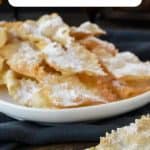
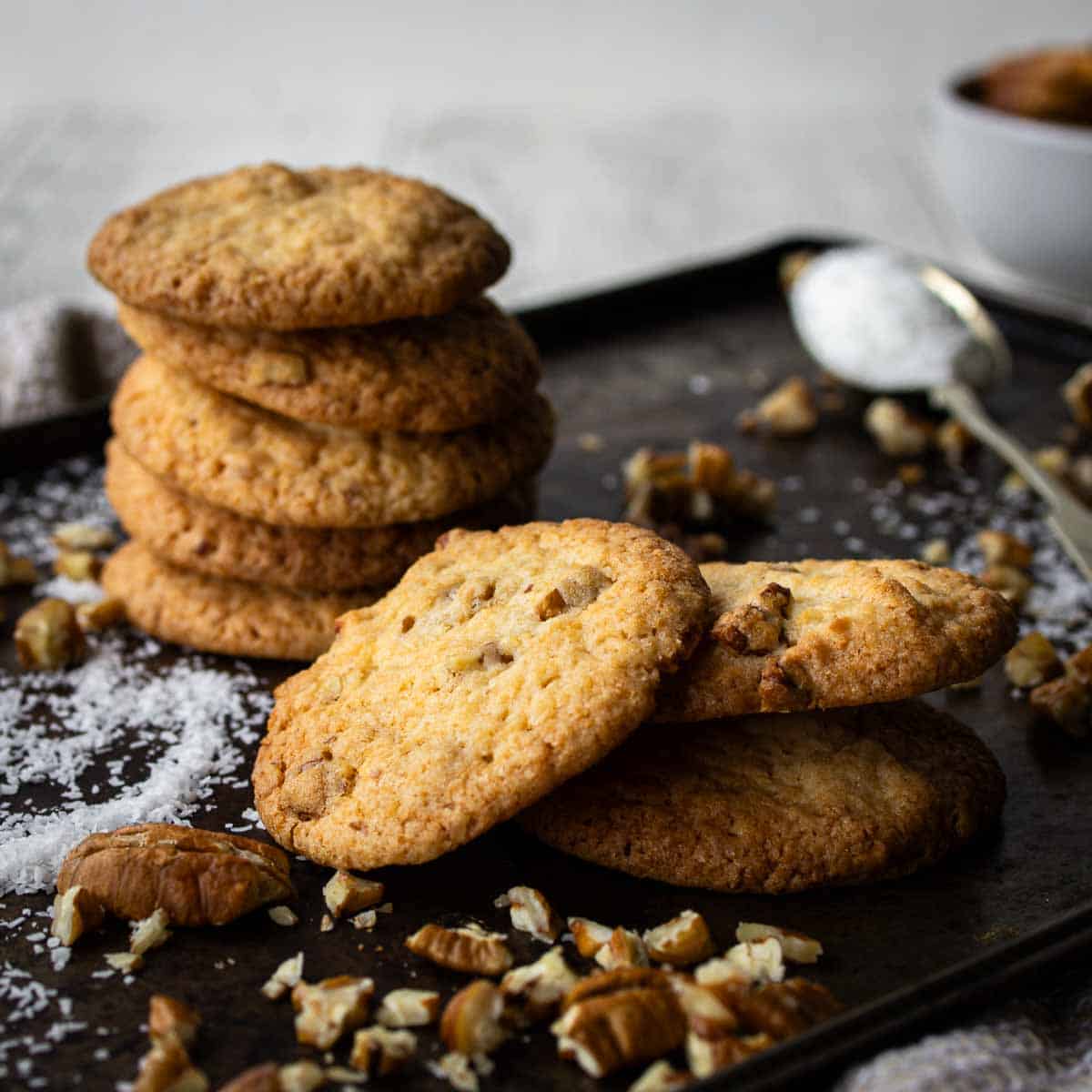
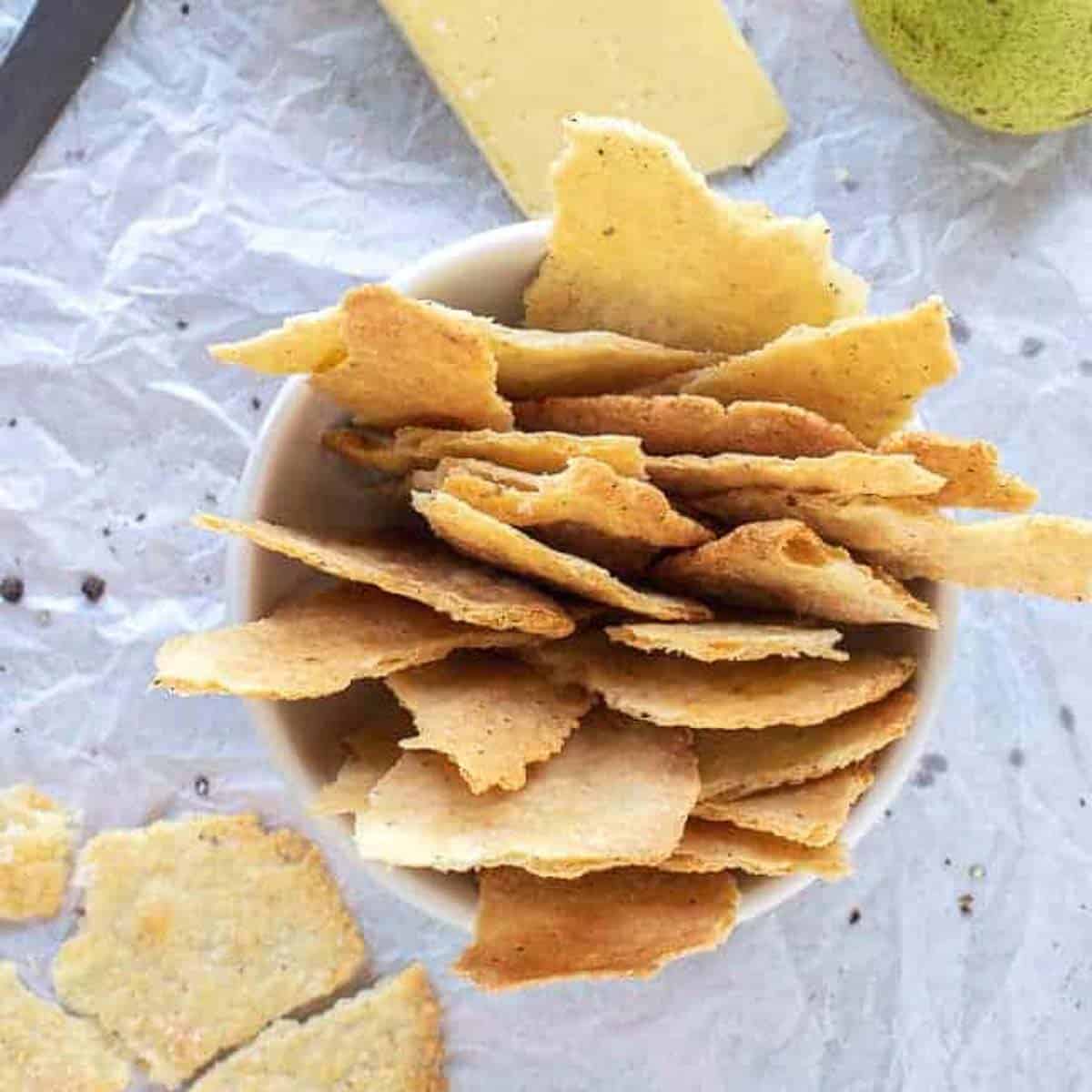
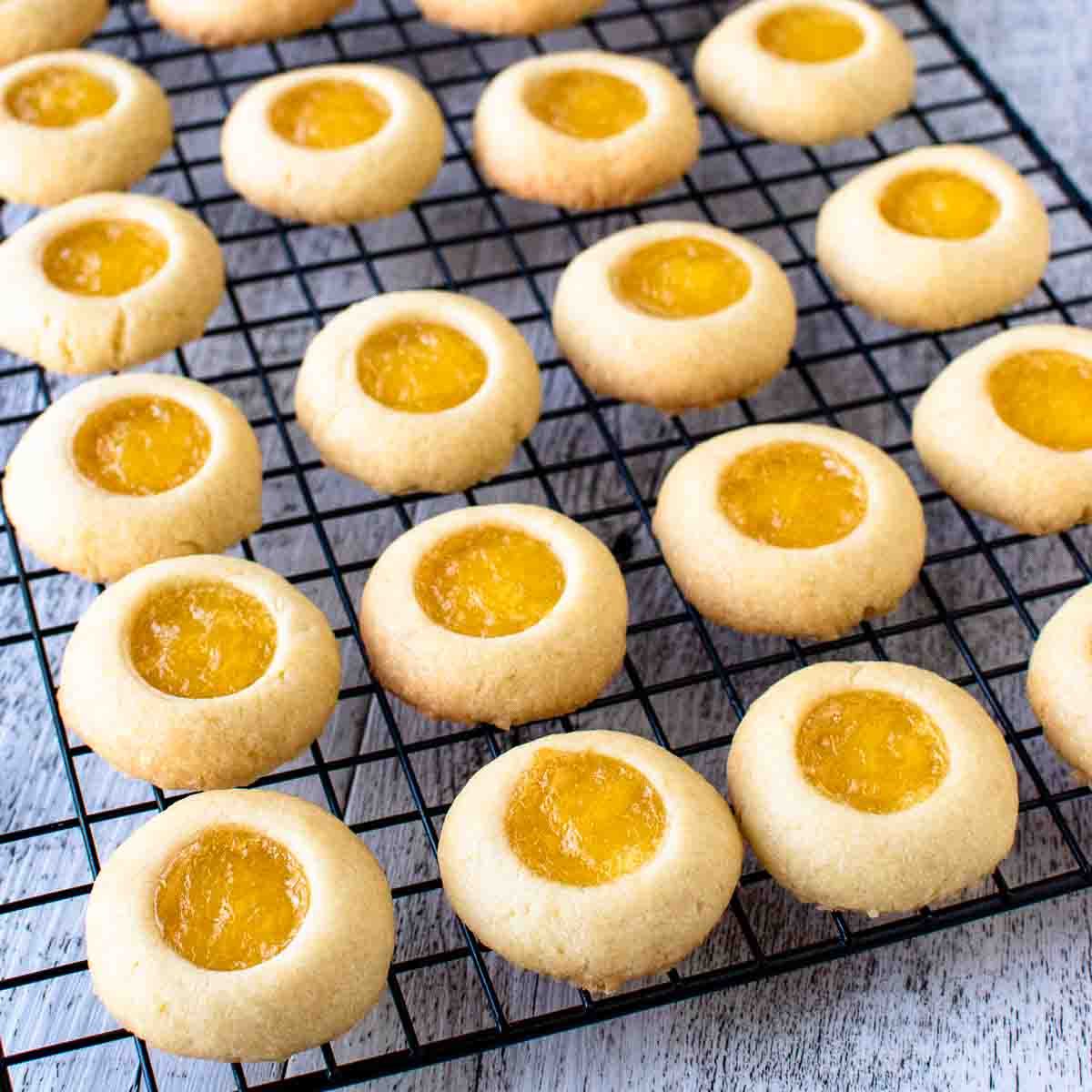
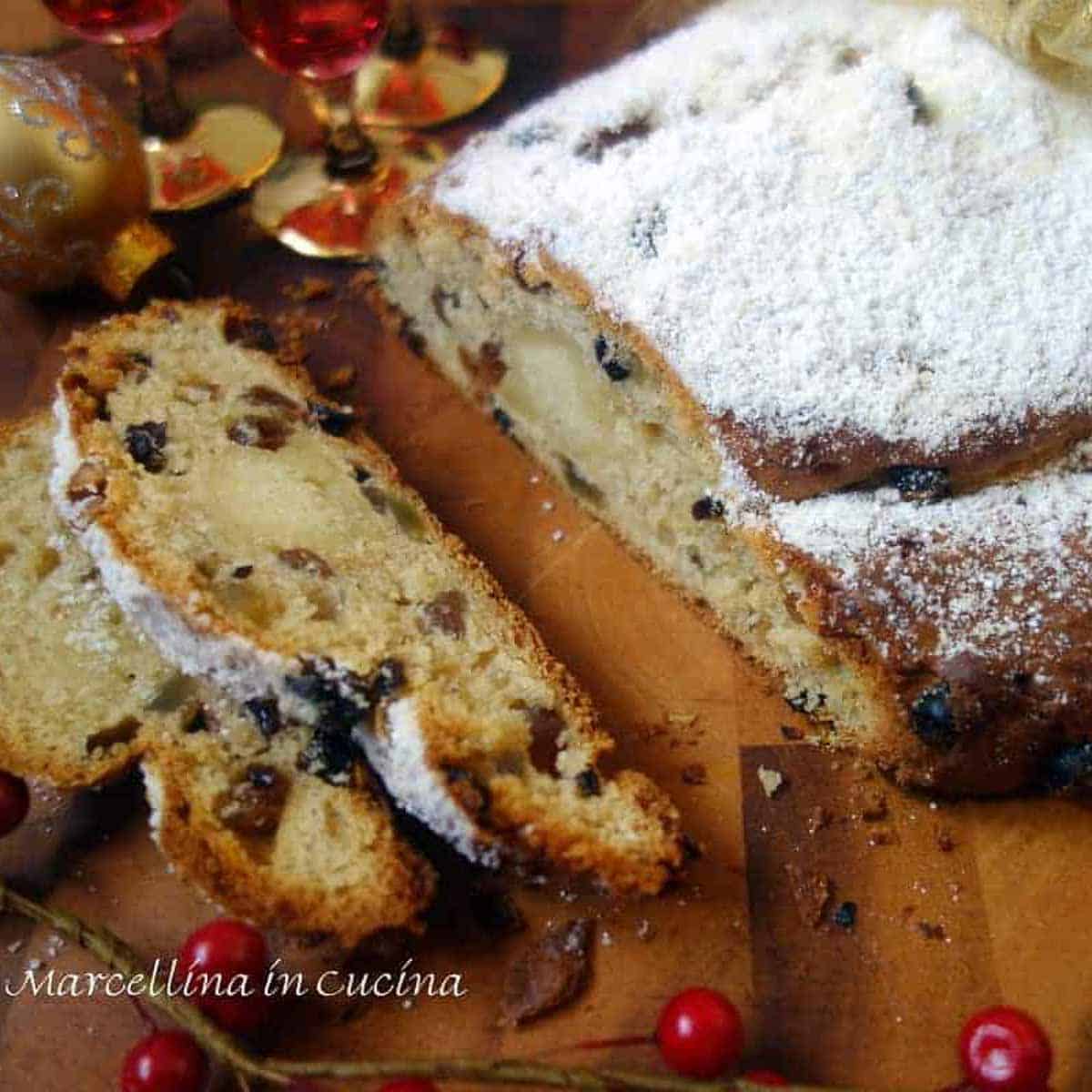
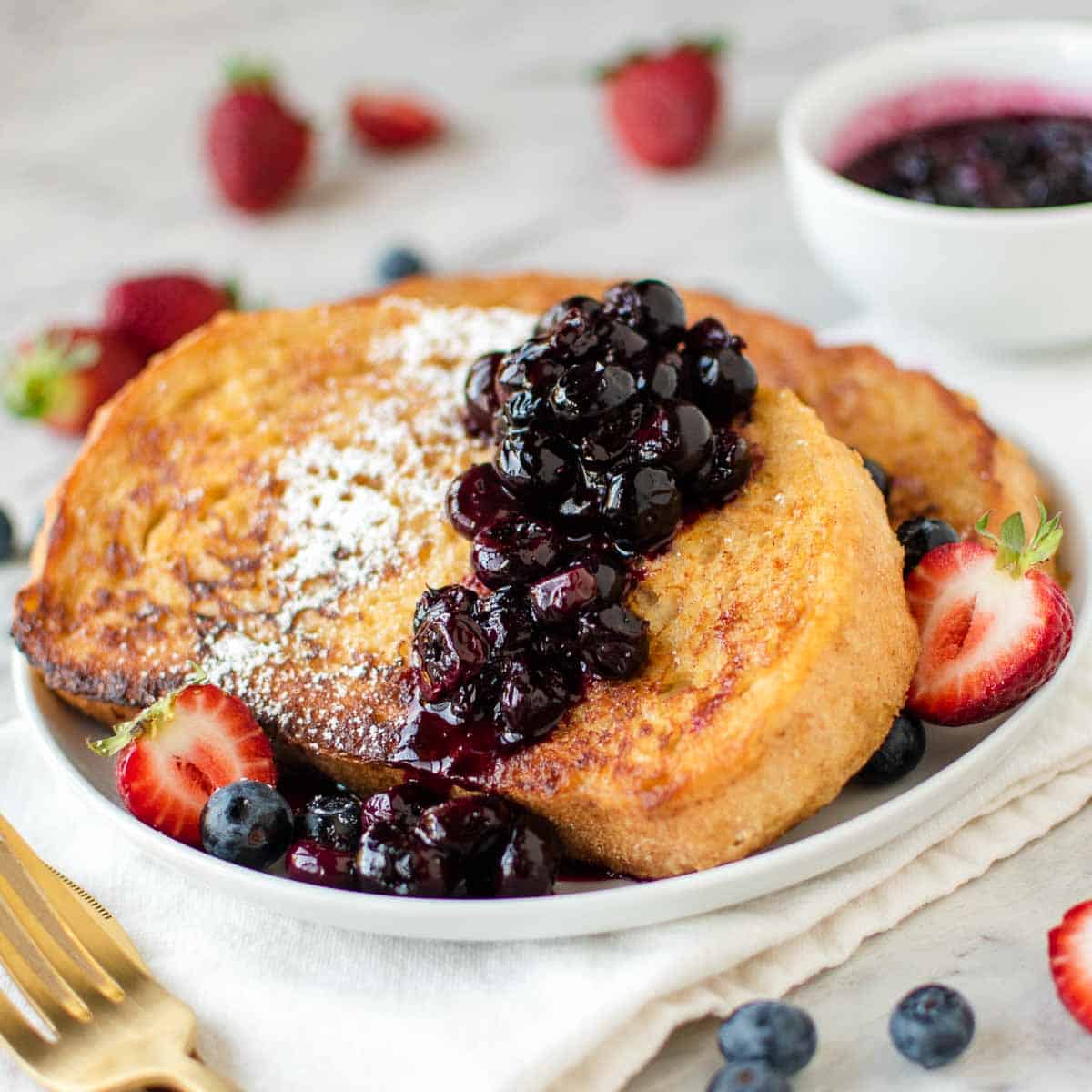
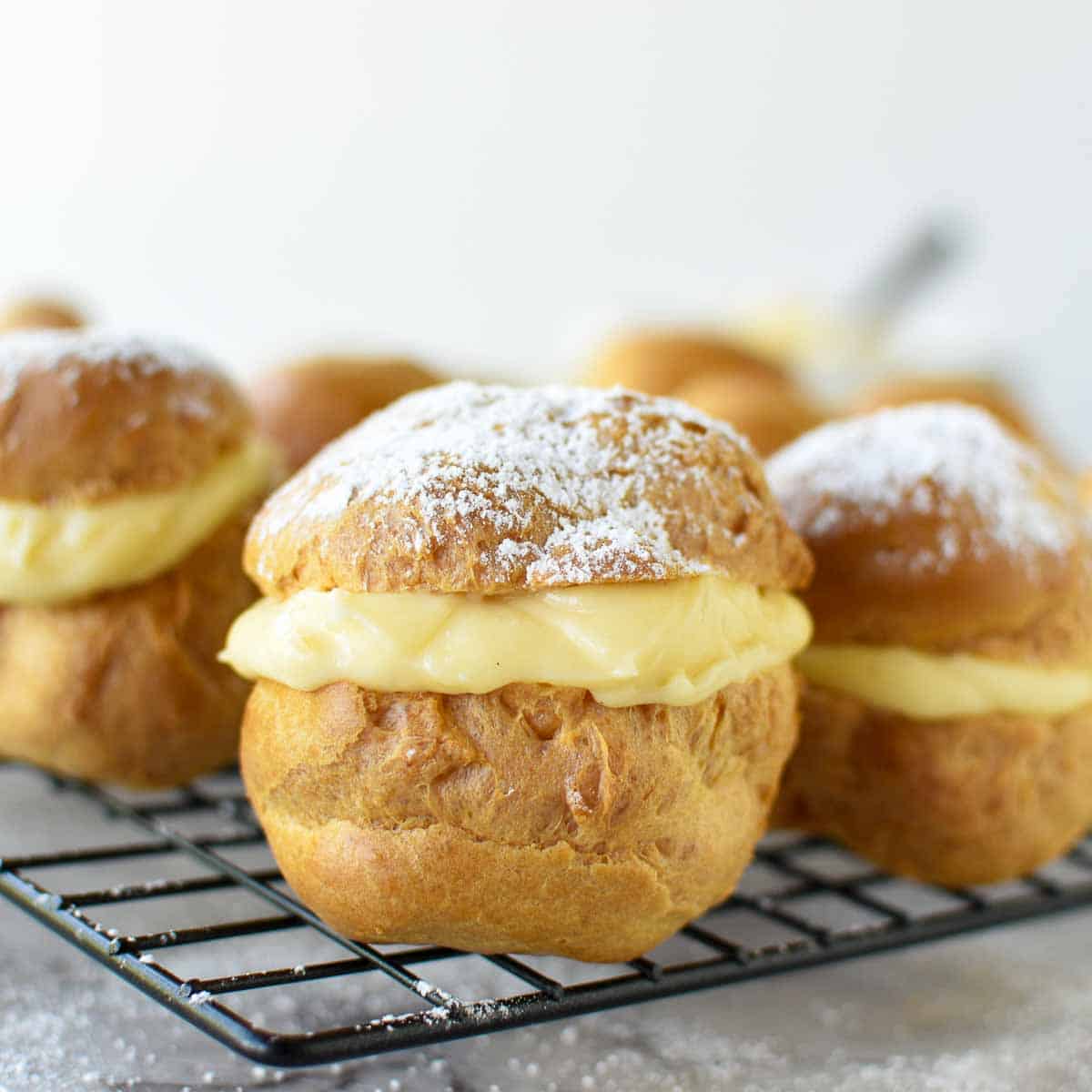
I am excited to try this recipe. I have my grandma’s recipe but no matter what do it’s always so sticky and if I add enough flour to make it not so sticky it becomes so elasticy its almost impossible to roll out. I’m sure there’s something missing as it was passed to me by my aunt. just trying to keep grandma’s tradition.
That’s interesting. I think that could be because the gluten is too developed after working in the extra flour. Hopefully this recipe works for you and you keep your grandma’s tradition.
My dad made these and fritelli di riso every Easter and Christmas. I learnt how to make the fritelli but never the crostolli. He has now passed and every year at Christmas I keep up the tradition,this year I will add the crostolli.
Thank you
You’re welcome, Giulia! Sounds like a wonderful Christmas tradition!
I made these when I was a little girl with my nonna now i want to make them with my little girls. thank you
Annunziata, that’s so lovely! Food is all about memories and making memories! Enjoy!
The dough is very easy to work with. I worked with it by rolling it thin with a rolling pin instead and it worked very well. I had not made Crostoli in years so it took a short bit of time to get in the rhythm of putting them in the hot oil and quickly taking them out. But it was a very friendly recipe which I will keep and use again. Thank you for the nice recipe Marcellina.
Thanks Mandy! So glad the rolling pin worked well!
I am always amazed by how food recipes travel around the world and can be found on the other half of the planet. Our forefathers did not stay put, but travelled a lot and brought with them recipes to the new country.
My jaws dropped when seeing these crostoli because here in Norway we have a crostoli too, but it is called “Fattigmann” and that translates to Poor man. We also have a special kitchen tool that we roll over the dough that gives the typical shape of Crostoli/Fattigmann. The reason we called it “poor man” is probably because you might end up poor after making them. Luxury items like butter, cream, fine flour and brandy was only for the rich or the ones having large farms. The ordinary Norwegian could not afford these expensive items way back when “Poor man” first arrived here in Norway. That was in the 1700 th century. So they ended up as Christmas cakes. Traditionally in Norway we make 7 different cookies for Christmas, unless you are really wealthy and house-wifey, because then you make 15. A lot of our traditional cakes are being lost and forgotten but at least I still hold on to them. Our poor man cakes is actually a bit thicker and we don’t use icing sugar on them, but except for that, they are very similar. Thank you for sharing!
I love this history about Fattigmann! Yes, they’re so similar to Crostoli! I have made them once after reading about them in a cookbook by Greg Patent and marvelled at how much they were like crostoli. I’m fascinated by the tool you have that gives the shape to the Norwegian Fattigmann. They 7 different cookies for Christmas sound amazing!
this recipe makes my heart smile. I see my mama standing at the stove, the table covered with powdered sugar……………..I’m sending it on to my kids, hoping they’ll bring me some. Thank you for the vision Marcellina. love,lyn
What a beautiful memory, Lyn! Thank you for sharing it with me xx
nothing better than fried dough
Absolutely!
ourfamily loves them , makes us think of the good ole days with all the family comes to eat all the wonderful recipes. Thank you!
So true, Elaine! Good food and family!
This is a 10 STAR rating❣❣Absolutely addicting!!!! Your directions and tutorial were so easy to follow. I will be making these quite often as they are light and fluffy!!! Cannot wait to try you pignoli cookies….
I’m so glad you love our family recipe!
One of my favorite recipes! So delicious!
Happy to hear that, Elizabeth!
these are soooo yummy! i love this!! pinned for later!
These were so easy to make-Directions were easy to follow. AND they are wonderful!
Thanks!
My boys have requested an Italian feast for their birthday celebration next month and I think these crostoli would be a fun and delicious addition. I’m sure they will be amazing just like all of your other recipes.
Oooooh, I hope your boys enjoy their special birthday celebrations!
These do look addicting and such a fun dessert to serve.I love the shape and of course the powdered sugar ontop.
You’ve got it, Jere! Totally addictive!
I haven’t heard of this, but I have had something similar. It would be fun to make this with the kids, as I am sure they would absolutely love it!
Marysa, kids love these – sweet and crispy!
Can these be made in an air fryer if I PREHEAT it to the correct temperature?
Hi Judy! I have never made these in the air fryer but I can’t see why not. Experience tells me that they wouldn’t be as light and the texture would be slightly different. However if you are looking to reduce oil and avoid frying this is a good option. Experiment with the thickness of the dough and time. I’d love to hear about your air fryer crostoli!
Hi Marcellina
These were the best I ever made!!!
Thank you so much for sharing your wonderful recipe. My only complaint making these was that my husband was eating them as fast as they were coming out of the oil. He loved them too!!
I love trying new recipes from other countries and these are fantastic!
Wow, these are SO delicious. Very light and delicate, we’ve never had this before and now it’s a favorite.
Fantastic recipe and tips. It works perfectly every time. Thanks Marcellina.
thanks for introducing me to Crostoli . they are so crispy !
You’re welcome, Nancy!
These were amazing. So light and delicate. Pasta machine works so well to make these paper thin. Thank you for sharing your recipe!!
The pasta machine is ideal for crostoli!
Hi Marcellina my name is Carmen Tubaro from South Africa. Your recipe for Crostoli was so quick and easy and ever so delicious. Thanks for sharing your recipe and look forward to trying out more of your recipes.
Buone Feste.
Hello Carmen! So wonderful to hear from you! My family has been using that recipe for years and we love it too! Buone Feste!